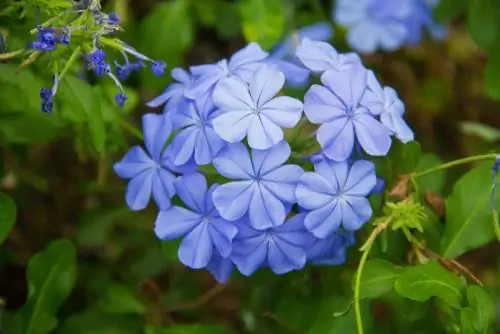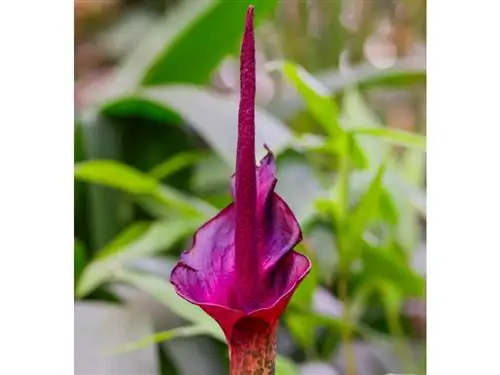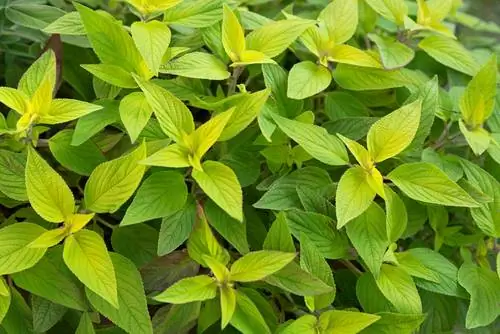- Author admin [email protected].
- Public 2023-12-25 17:45.
- Last modified 2025-01-23 11:22.
When the opulent leadwort opens its floral cornucopia in May, cascades of flowers flow from sky blue to bright white. These answers to frequently asked questions explain the conditions under which the exotic subshrub thrives over the course of several years.

How do I care for a leadwort plant?
To successfully cultivate leadwort, choose a sunny location, use structurally stable container plant soil, keep the substrate moist (without waterlogging), fertilize weekly and cut back the plant regularly. Wintering takes place at 6 to 10 degrees Celsius.
Planting leadwort correctly
The quality of the soil largely determines the successful cultivation of leadwort. Therefore, invest in a structurally stable pot plant soil (€18.00 at Amazon) based on compost that contains little or no peat. Add a handful of quartz sand and lava granules for best permeability. Above the floor opening, a few pieces of pottery serve as drainage to prevent disastrous waterlogging. Fill in a first layer of potting soil high enough to maintain the planting depth of the growing container. Now pot up the young plant, place it in the middle and fill the cavity with soil. A pouring edge of 2-3 cm ensures that nothing spills over later. Water on the day of planting and regularly afterwards so that the roots spread quickly.
Care tips
Your efforts to have a lush blooming leadwort will be successful if you follow the following care program:
- Keep the substrate constantly moist during the summer
- Fertilize weekly from April to September
- Consistently clean out or cut out wilted (very sticky) flowers
- Comprehensive pruning in autumn or at the end of February/beginning of March
If the leadwort lingers on the summer balcony or on the sunny seat in the garden, it moves to its winter quarters in autumn. It's not too dark there and, above all, cool, at 6 to 10 degrees. Until the end of February, water only occasionally. Fertilization is not carried out during dormant growth.read more
Which location is suitable?
So that the tropical beauty can demonstrate its floral power, the location should be as sunny as possible. In partial shade the flowers are a little sparser. Since the cascading overhanging branches can quickly break, we recommend a location protected from the wind. As a substrate, choose a well-drained, nutrient-rich compost-based container plant soil.
When is flowering time?
The flowering period of a leadwort extends from the end of spring into autumn. Look forward to dense carpets of flowers from May to October, accompanied by small, green leaves that turn golden yellow in autumn. To maintain a well-groomed appearance and regularly create space for new flowers, clean out wilted and faded flowers as soon as possible. Unfortunately, the plant does not produce the slightly sticky flowers automatically.
Cut leadwort correctly
Scissors play an important role in care. To ensure that the vigorous leadwort maintains a compact and bushy stature, consistently cut off shoots that are too long during the year. For a distinctive ornamental shrub in a pot on the balcony, shorten the branches to a length of 40 cm. Either before clearing away or at the end of February/beginning of March, carry out a shape and maintenance cut of up to two thirds. At the same time, thin out the bush thoroughly, whereupon vigorous shoots will begin from April. To train the tree to become an elegant standard tree, place a strong shoot on the trunk. All unnecessary side shoots are regularly cut off up to the height of the crown.read more
Watering leadwort
Keep the substrate evenly moist throughout the summer. Avoid both waterlogging and drought stress, as leadwort takes offense at both. It is beneficial for floral vitality to alternately use calcareous tap water and soft rainwater. During the winter break, reduce the amount of water you give, adapting it to the lower needs.
Fertilize leadwort properly
A plentiful supply of nutrients is one of the mainstays of professional leadwort care. From April to September, add a liquid fertilizer to the water every week. If this is too much effort for you, use fertilizer sticks with a long-term effect. These are pressed into the substrate every 3 months, where they gradually release the nutrients.
Wintering
If the mercury falls permanently below 10 degrees Celsius in autumn, it is time to put away the leadwort. This is how wintering works without any ifs and buts:
- Place in a not too dark room at 6 to 10 degrees
- Water every now and then so that the root ball doesn't dry out
- Do not apply fertilizer from October to March
- Repot into fresh substrate in early spring
If the space in the winter quarters is limited, cut the ornamental shrub back heavily before putting it away. Otherwise, the end of February/beginning of March is the ideal date for a comprehensive shape and maintenance pruning. Don't be afraid to proceed boldly, because the tropical beauty only blooms on this year's shoots. After pruning, the plumbago moves to a brighter and warmer location to prepare for the next season.read more
Propagate leadwort
Once you have discovered your joy in the lavishly flowering leadwort, you can breed additional specimens using cuttings. To do this, cut non-flowering head cuttings with a length of 10 to 15 cm in summer. These are stripped of their leaves in the lower half and planted in pots with a poor substrate. Put over a transparent hood and place your pupils in the partially shaded window seat at 20 degrees Celsius. While you keep the potting soil constantly moist, rooting will progress quickly. If the first shoots sprout, the hood can be removed. By next spring, the cuttings will have turned into strong young plants, fit enough to be planted in a pot on the summer balcony.read more
Is leadwort poisonous?
The tropical leadwort contains plumbagin, which emerges as sticky flower sap. Anyone who is allergic to this ingredient should wear gloves to protect themselves from skin irritation when planting and caring for the plant. Otherwise, the exotic ornamental plant poses no he alth threat, so there is nothing wrong with cultivating it in the family garden.read more
Trivia
The leadwort owes its cumbersome name neither to its delicate flowers nor to its easy care. In fact, the plant sap turns human skin lead-gray, which was used in earlier times for body painting and tattoos. The Latin name for lead is Plumbum, which gives rise to the botanical genus name Plumbago - in German Bleiwurz.
Beautiful varieties
- Caerulia: Beautiful leadwort with sky-blue flowers from May to autumn; perfect ground cover
- Burma Plumwort: Thrives as a knee-high ornamental shrub with bright blue flowers all summer long
- Alba: Cape leadwort with drooping branches dotted with white flowers; the ideal variety for summer hanging baskets
- Royal Cape: Elegant Cape Leadwort, which stands out with dark blue flowers and reaches up to 200 cm as a standard stem






